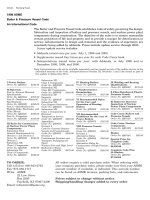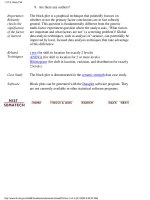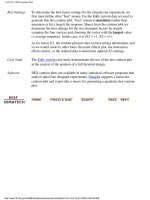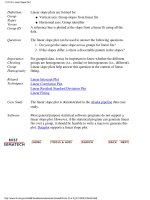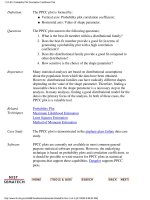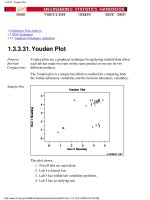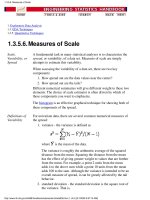Engineering Statistics Handbook Episode 1 Part 11 ppsx
Bạn đang xem bản rút gọn của tài liệu. Xem và tải ngay bản đầy đủ của tài liệu tại đây (84.1 KB, 20 trang )
Alternative
Measures of
Location
A few of the more common alternative location measures are:
Mid-Mean - computes a mean using the data between the 25th
and 75th percentiles.
1.
Trimmed Mean - similar to the mid-mean except different
percentile values are used. A common choice is to trim 5% of the
points in both the lower and upper tails, i.e., calculate the mean
for data between the 5th and 95th percentiles.
2.
Winsorized Mean - similar to the trimmed mean. However,
instead of trimming the points, they are set to the lowest (or
highest) value. For example, all data below the 5th percentile are
set equal to the value of the 5th percentile and all data greater
than the 95th percentile are set equal to the 95th percentile.
3.
Mid-range = (smallest + largest)/2.4.
The first three alternative location estimators defined above have the
advantage of the median in the sense that they are not unduly affected
by extremes in the tails. However, they generate estimates that are closer
to the mean for data that are normal (or nearly so).
The mid-range, since it is based on the two most extreme points, is not
robust. Its use is typically restricted to situations in which the behavior
at the extreme points is relevant.
Case Study
The uniform random numbers case study compares the performance of
several different location estimators for a particular non-normal
distribution.
Software
Most general purpose statistical software programs, including Dataplot,
can compute at least some of the measures of location discussed above.
1.3.5.1. Measures of Location
(5 of 5) [5/1/2006 9:57:12 AM]
This simply means that noisy data, i.e., data with a large standard deviation, are
going to generate wider intervals than data with a smaller standard deviation.
Definition:
Hypothesis
Test
To test whether the population mean has a specific value,
, against the two-sided
alternative that it does not have a value
, the confidence interval is converted to
hypothesis-test form. The test is a one-sample t-test, and it is defined as:
H
0
:
H
a
:
Test Statistic:
where , N, and are defined as above.
Significance Level:
. The most commonly used value for is 0.05.
Critical Region: Reject the null hypothesis that the mean is a specified value,
,
if
or
Sample
Output for
Confidence
Interval
Dataplot generated the following output for a confidence interval from the
ZARR13.DAT data set:
CONFIDENCE LIMITS FOR MEAN
(2-SIDED)
NUMBER OF OBSERVATIONS = 195
MEAN = 9.261460
STANDARD DEVIATION = 0.2278881E-01
STANDARD DEVIATION OF MEAN = 0.1631940E-02
CONFIDENCE T T X SD(MEAN) LOWER UPPER
VALUE (%) VALUE LIMIT LIMIT
50.000 0.676 0.110279E-02 9.26036 9.26256
75.000 1.154 0.188294E-02 9.25958 9.26334
90.000 1.653 0.269718E-02 9.25876 9.26416
95.000 1.972 0.321862E-02 9.25824 9.26468
99.000 2.601 0.424534E-02 9.25721 9.26571
99.900 3.341 0.545297E-02 9.25601 9.26691
99.990 3.973 0.648365E-02 9.25498 9.26794
99.999 4.536 0.740309E-02 9.25406 9.26886
1.3.5.2. Confidence Limits for the Mean
(2 of 4) [5/1/2006 9:57:13 AM]
Interpretation
of the Sample
Output
The first few lines print the sample statistics used in calculating the confidence
interval. The table shows the confidence interval for several different significance
levels. The first column lists the confidence level (which is 1 -
expressed as a
percent), the second column lists the t-value (i.e.,
), the third column lists
the t-value times the standard error (the standard error is
), the fourth column
lists the lower confidence limit, and the fifth column lists the upper confidence limit.
For example, for a 95% confidence interval, we go to the row identified by 95.000 in
the first column and extract an interval of (9.25824, 9.26468) from the last two
columns.
Output from other statistical software may look somewhat different from the above
output.
Sample
Output for t
Test
Dataplot generated the following output for a one-sample t-test from the
ZARR13.DAT data set:
T TEST
(1-SAMPLE)
MU0 = 5.000000
NULL HYPOTHESIS UNDER TEST MEAN MU = 5.000000
SAMPLE:
NUMBER OF OBSERVATIONS = 195
MEAN = 9.261460
STANDARD DEVIATION = 0.2278881E-01
STANDARD DEVIATION OF MEAN = 0.1631940E-02
TEST:
MEAN-MU0 = 4.261460
T TEST STATISTIC VALUE = 2611.284
DEGREES OF FREEDOM = 194.0000
T TEST STATISTIC CDF VALUE = 1.000000
ALTERNATIVE- ALTERNATIVE-
ALTERNATIVE- HYPOTHESIS HYPOTHESIS
HYPOTHESIS ACCEPTANCE INTERVAL CONCLUSION
MU <> 5.000000 (0,0.025) (0.975,1) ACCEPT
MU < 5.000000 (0,0.05) REJECT
MU > 5.000000 (0.95,1) ACCEPT
1.3.5.2. Confidence Limits for the Mean
(3 of 4) [5/1/2006 9:57:13 AM]
Interpretation
of Sample
Output
We are testing the hypothesis that the population mean is 5. The output is divided into
three sections.
The first section prints the sample statistics used in the computation of the t-test.1.
The second section prints the t-test statistic value, the degrees of freedom, and
the cumulative distribution function (cdf) value of the t-test statistic. The t-test
statistic cdf value is an alternative way of expressing the critical value. This cdf
value is compared to the acceptance intervals printed in section three. For an
upper one-tailed test, the alternative hypothesis acceptance interval is (1 -
,1),
the alternative hypothesis acceptance interval for a lower one-tailed test is (0,
), and the alternative hypothesis acceptance interval for a two-tailed test is (1 -
/2,1) or (0, /2). Note that accepting the alternative hypothesis is equivalent to
rejecting the null hypothesis.
2.
The third section prints the conclusions for a 95% test since this is the most
common case. Results are given in terms of the alternative hypothesis for the
two-tailed test and for the one-tailed test in both directions. The alternative
hypothesis acceptance interval column is stated in terms of the cdf value printed
in section two. The last column specifies whether the alternative hypothesis is
accepted or rejected. For a different significance level, the appropriate
conclusion can be drawn from the t-test statistic cdf value printed in section
two. For example, for a significance level of 0.10, the corresponding alternative
hypothesis acceptance intervals are (0,0.05) and (0.95,1), (0, 0.10), and (0.90,1).
3.
Output from other statistical software may look somewhat different from the above
output.
Questions Confidence limits for the mean can be used to answer the following questions:
What is a reasonable estimate for the mean?1.
How much variability is there in the estimate of the mean?2.
Does a given target value fall within the confidence limits?3.
Related
Techniques
Two-Sample T-Test
Confidence intervals for other location estimators such as the median or mid-mean
tend to be mathematically difficult or intractable. For these cases, confidence intervals
can be obtained using the bootstrap.
Case Study
Heat flow meter data.
Software Confidence limits for the mean and one-sample t-tests are available in just about all
general purpose statistical software programs, including Dataplot.
1.3.5.2. Confidence Limits for the Mean
(4 of 4) [5/1/2006 9:57:13 AM]
Test
Statistic:
where N
1
and N
2
are the sample sizes, and are the sample
means, and
and are the sample variances.
If equal variances are assumed, then the formula reduces to:
where
Significance
Level:
.
Critical
Region:
Reject the null hypothesis that the two means are equal if
or
where is the critical value of the t distribution with
degrees of freedom where
If equal variances are assumed, then
Sample
Output
Dataplot generated the following output for the t test from the AUTO83B.DAT
data set:
T TEST
(2-SAMPLE)
NULL HYPOTHESIS UNDER TEST POPULATION MEANS MU1 = MU2
SAMPLE 1:
NUMBER OF OBSERVATIONS = 249
MEAN = 20.14458
STANDARD DEVIATION = 6.414700
STANDARD DEVIATION OF MEAN = 0.4065151
1.3.5.3. Two-Sample t-Test for Equal Means
(2 of 4) [5/1/2006 9:57:14 AM]
SAMPLE 2:
NUMBER OF OBSERVATIONS = 79
MEAN = 30.48101
STANDARD DEVIATION = 6.107710
STANDARD DEVIATION OF MEAN = 0.6871710
IF ASSUME SIGMA1 = SIGMA2:
POOLED STANDARD DEVIATION = 6.342600
DIFFERENCE (DEL) IN MEANS = -10.33643
STANDARD DEVIATION OF DEL = 0.8190135
T TEST STATISTIC VALUE = -12.62059
DEGREES OF FREEDOM = 326.0000
T TEST STATISTIC CDF VALUE = 0.000000
IF NOT ASSUME SIGMA1 = SIGMA2:
STANDARD DEVIATION SAMPLE 1 = 6.414700
STANDARD DEVIATION SAMPLE 2 = 6.107710
BARTLETT CDF VALUE = 0.402799
DIFFERENCE (DEL) IN MEANS = -10.33643
STANDARD DEVIATION OF DEL = 0.7984100
T TEST STATISTIC VALUE = -12.94627
EQUIVALENT DEG. OF FREEDOM = 136.8750
T TEST STATISTIC CDF VALUE = 0.000000
ALTERNATIVE- ALTERNATIVE-
ALTERNATIVE- HYPOTHESIS HYPOTHESIS
HYPOTHESIS ACCEPTANCE INTERVAL CONCLUSION
MU1 <> MU2 (0,0.025) (0.975,1) ACCEPT
MU1 < MU2 (0,0.05) ACCEPT
MU1 > MU2 (0.95,1) REJECT
Interpretation
of Sample
Output
We are testing the hypothesis that the population mean is equal for the two
samples. The output is divided into five sections.
The first section prints the sample statistics for sample one used in the
computation of the t-test.
1.
The second section prints the sample statistics for sample two used in the
computation of the t-test.
2.
The third section prints the pooled standard deviation, the difference in the
means, the t-test statistic value, the degrees of freedom, and the cumulative
distribution function (cdf) value of the t-test statistic under the assumption
that the standard deviations are equal. The t-test statistic cdf value is an
alternative way of expressing the critical value. This cdf value is compared
to the acceptance intervals printed in section five. For an upper one-tailed
test, the acceptance interval is (0,1 -
), the acceptance interval for a
two-tailed test is (
/2, 1 - /2), and the acceptance interval for a lower
3.
1.3.5.3. Two-Sample t-Test for Equal Means
(3 of 4) [5/1/2006 9:57:14 AM]
one-tailed test is ( ,1).
The fourth section prints the pooled standard deviation, the difference in
the means, the t-test statistic value, the degrees of freedom, and the
cumulative distribution function (cdf) value of the t-test statistic under the
assumption that the standard deviations are not equal. The t-test statistic cdf
value is an alternative way of expressing the critical value. cdf value is
compared to the acceptance intervals printed in section five. For an upper
one-tailed test, the alternative hypothesis acceptance interval is (1 -
,1),
the alternative hypothesis acceptance interval for a lower one-tailed test is
(0,
), and the alternative hypothesis acceptance interval for a two-tailed
test is (1 -
/2,1) or (0, /2). Note that accepting the alternative hypothesis
is equivalent to rejecting the null hypothesis.
4.
The fifth section prints the conclusions for a 95% test under the assumption
that the standard deviations are not equal since a 95% test is the most
common case. Results are given in terms of the alternative hypothesis for
the two-tailed test and for the one-tailed test in both directions. The
alternative hypothesis acceptance interval column is stated in terms of the
cdf value printed in section four. The last column specifies whether the
alternative hypothesis is accepted or rejected. For a different significance
level, the appropriate conclusion can be drawn from the t-test statistic cdf
value printed in section four. For example, for a significance level of 0.10,
the corresponding alternative hypothesis acceptance intervals are (0,0.05)
and (0.95,1), (0, 0.10), and (0.90,1).
5.
Output from other statistical software may look somewhat different from the
above output.
Questions Two-sample t-tests can be used to answer the following questions:
Is process 1 equivalent to process 2?1.
Is the new process better than the current process?2.
Is the new process better than the current process by at least some
pre-determined threshold amount?
3.
Related
Techniques
Confidence Limits for the Mean
Analysis of Variance
Case Study
Ceramic strength data.
Software Two-sample t-tests are available in just about all general purpose statistical
software programs, including Dataplot.
1.3.5.3. Two-Sample t-Test for Equal Means
(4 of 4) [5/1/2006 9:57:14 AM]
18 19
14 32
14 34
14 26
14 30
12 22
13 22
13 33
18 39
22 36
19 28
18 27
23 21
26 24
25 30
20 34
21 32
13 38
14 37
15 30
14 31
17 37
11 32
13 47
12 41
13 45
15 34
13 33
13 24
14 32
22 39
28 35
13 32
14 37
13 38
14 34
15 34
12 32
13 33
13 32
14 25
13 24
12 37
13 31
18 36
16 36
1.3.5.3.1. Data Used for Two-Sample t-Test
(2 of 6) [5/1/2006 9:57:14 AM]
18 34
18 38
23 32
11 38
12 32
13 -999
12 -999
18 -999
21 -999
19 -999
21 -999
15 -999
16 -999
15 -999
11 -999
20 -999
21 -999
19 -999
15 -999
26 -999
25 -999
16 -999
16 -999
18 -999
16 -999
13 -999
14 -999
14 -999
14 -999
28 -999
19 -999
18 -999
15 -999
15 -999
16 -999
15 -999
16 -999
14 -999
17 -999
16 -999
15 -999
18 -999
21 -999
20 -999
13 -999
23 -999
1.3.5.3.1. Data Used for Two-Sample t-Test
(3 of 6) [5/1/2006 9:57:14 AM]
20 -999
23 -999
18 -999
19 -999
25 -999
26 -999
18 -999
16 -999
16 -999
15 -999
22 -999
22 -999
24 -999
23 -999
29 -999
25 -999
20 -999
18 -999
19 -999
18 -999
27 -999
13 -999
17 -999
13 -999
13 -999
13 -999
30 -999
26 -999
18 -999
17 -999
16 -999
15 -999
18 -999
21 -999
19 -999
19 -999
16 -999
16 -999
16 -999
16 -999
25 -999
26 -999
31 -999
34 -999
36 -999
20 -999
1.3.5.3.1. Data Used for Two-Sample t-Test
(4 of 6) [5/1/2006 9:57:14 AM]
19 -999
20 -999
19 -999
21 -999
20 -999
25 -999
21 -999
19 -999
21 -999
21 -999
19 -999
18 -999
19 -999
18 -999
18 -999
18 -999
30 -999
31 -999
23 -999
24 -999
22 -999
20 -999
22 -999
20 -999
21 -999
17 -999
18 -999
17 -999
18 -999
17 -999
16 -999
19 -999
19 -999
36 -999
27 -999
23 -999
24 -999
34 -999
35 -999
28 -999
29 -999
27 -999
34 -999
32 -999
28 -999
26 -999
1.3.5.3.1. Data Used for Two-Sample t-Test
(5 of 6) [5/1/2006 9:57:14 AM]
24 -999
19 -999
28 -999
24 -999
27 -999
27 -999
26 -999
24 -999
30 -999
39 -999
35 -999
34 -999
30 -999
22 -999
27 -999
20 -999
18 -999
28 -999
27 -999
34 -999
31 -999
29 -999
27 -999
24 -999
23 -999
38 -999
36 -999
25 -999
38 -999
26 -999
22 -999
36 -999
27 -999
27 -999
32 -999
28 -999
31 -999
1.3.5.3.1. Data Used for Two-Sample t-Test
(6 of 6) [5/1/2006 9:57:14 AM]
The distinction between these models is that the second model divides
the cell mean into an overall mean and the effect of the ith factor level.
This second model makes the factor effect more explicit, so we will
emphasize this approach.
Model
Validation
Note that the ANOVA model assumes that the error term, E
ij
, should
follow the assumptions for a univariate measurement process. That is,
after performing an analysis of variance, the model should be validated
by analyzing the residuals.
Sample
Output
Dataplot generated the following output for the one-way analysis of variance from the
GEAR.DAT data set.
NUMBER OF OBSERVATIONS = 100
NUMBER OF FACTORS = 1
NUMBER OF LEVELS FOR FACTOR 1 = 10
BALANCED CASE
RESIDUAL STANDARD DEVIATION =
0.59385783970E-02
RESIDUAL DEGREES OF FREEDOM = 90
REPLICATION CASE
REPLICATION STANDARD DEVIATION =
0.59385774657E-02
REPLICATION DEGREES OF FREEDOM = 90
NUMBER OF DISTINCT CELLS = 10
*****************
* ANOVA TABLE *
*****************
SOURCE DF SUM OF SQUARES MEAN SQUARE F
STATISTIC F CDF SIG
TOTAL (CORRECTED) 99 0.003903 0.000039
FACTOR 1 9 0.000729 0.000081
2.2969 97.734% *
RESIDUAL 90 0.003174 0.000035
RESIDUAL STANDARD DEVIATION = 0.00593857840
RESIDUAL DEGREES OF FREEDOM = 90
REPLICATION STANDARD DEVIATION = 0.00593857747
REPLICATION DEGREES OF FREEDOM = 90
****************
* ESTIMATION *
****************
GRAND MEAN =
0.99764001369E+00
GRAND STANDARD DEVIATION =
0.62789078802E-02
1.3.5.4. One-Factor ANOVA
(2 of 4) [5/1/2006 9:57:15 AM]
LEVEL-ID NI MEAN EFFECT
SD(EFFECT)
FACTOR 1 1.00000 10. 0.99800 0.00036
0.00178
2.00000 10. 0.99910 0.00146
0.00178
3.00000 10. 0.99540 -0.00224
0.00178
4.00000 10. 0.99820 0.00056
0.00178
5.00000 10. 0.99190 -0.00574
0.00178
6.00000 10. 0.99880 0.00116
0.00178
7.00000 10. 1.00150 0.00386
0.00178
8.00000 10. 1.00040 0.00276
0.00178
9.00000 10. 0.99830 0.00066
0.00178
10.00000 10. 0.99480 -0.00284
0.00178
MODEL RESIDUAL STANDARD DEVIATION
CONSTANT ONLY 0.0062789079
CONSTANT & FACTOR 1 ONLY 0.0059385784
Interpretation
of Sample
Output
The output is divided into three sections.
The first section prints the number of observations (100), the
number of factors (10), and the number of levels for each factor
(10 levels for factor 1). It also prints some overall summary
statistics. In particular, the residual standard deviation is 0.0059.
The smaller the residual standard deviation, the more we have
accounted for the variance in the data.
1.
The second section prints an ANOVA table. The ANOVA table
decomposes the variance into the following component sum of
squares:
Total sum of squares. The degrees of freedom for this
entry is the number of observations minus one.
❍
Sum of squares for the factor. The degrees of freedom for
this entry is the number of levels minus one. The mean
square is the sum of squares divided by the number of
degrees of freedom.
❍
Residual sum of squares. The degrees of freedom is the
total degrees of freedom minus the factor degrees of
freedom. The mean square is the sum of squares divided
by the number of degrees of freedom.
❍
That is, it summarizes how much of the variance in the data
2.
1.3.5.4. One-Factor ANOVA
(3 of 4) [5/1/2006 9:57:15 AM]
(total sum of squares) is accounted for by the factor effect (factor
sum of squares) and how much is random error (residual sum of
squares). Ideally, we would like most of the variance to be
explained by the factor effect. The ANOVA table provides a
formal F test for the factor effect. The F-statistic is the mean
square for the factor divided by the mean square for the error.
This statistic follows an F distribution with (k-1) and (N-k)
degrees of freedom. If the F CDF column for the factor effect is
greater than 95%, then the factor is significant at the 5% level.
The third section prints an estimation section. It prints an overall
mean and overall standard deviation. Then for each level of each
factor, it prints the number of observations, the mean for the
observations of each cell (
in the above terminology), the
factor effect (
in the above terminology), and the standard
deviation of the factor effect. Finally, it prints the residual
standard deviation for the various possible models. For the
one-way ANOVA, the two models are the constant model, i.e.,
and the model with a factor effect
For these data, including the factor effect reduces the residual
standard deviation from 0.00623 to 0.0059. That is, although the
factor is statistically significant, it has minimal improvement
over a simple constant model. This is because the factor is just
barely significant.
3.
Output from other statistical software may look somewhat different
from the above output.
In addition to the quantitative ANOVA output, it is recommended that
any analysis of variance be complemented with model validation. At a
minimum, this should include
A run sequence plot of the residuals.1.
A normal probability plot of the residuals.2.
A scatter plot of the predicted values against the residuals.3.
Question The analysis of variance can be used to answer the following question
Are means the same across groups in the data?
●
Importance The analysis of uncertainty depends on whether the factor significantly
affects the outcome.
Related
Techniques
Two-sample t-test
Multi-factor analysis of variance
Regression
Box plot
Software
Most general purpose statistical software programs, including Dataplot,
can generate an analysis of variance.
1.3.5.4. One-Factor ANOVA
(4 of 4) [5/1/2006 9:57:15 AM]
factor effects ( and represent the effects of the ith level of the first
factor and the jth level of the second factor, respectively), and an error
term. The analysis of variance provides estimates of the grand mean and
the factor effects. The predicted values and the residuals of the model
are
The distinction between these models is that the second model divides
the cell mean into an overall mean and factor effects. This second model
makes the factor effect more explicit, so we will emphasize this
approach.
Model
Validation
Note that the ANOVA model assumes that the error term, E
ijk
, should
follow the assumptions for a univariate measurement process. That is,
after performing an analysis of variance, the model should be validated
by analyzing the residuals.
Sample
Output
Dataplot generated the following ANOVA output for the JAHANMI2.DAT data set:
**********************************
**********************************
** 4-WAY ANALYSIS OF VARIANCE **
**********************************
**********************************
NUMBER OF OBSERVATIONS = 480
NUMBER OF FACTORS = 4
NUMBER OF LEVELS FOR FACTOR 1 = 2
NUMBER OF LEVELS FOR FACTOR 2 = 2
NUMBER OF LEVELS FOR FACTOR 3 = 2
NUMBER OF LEVELS FOR FACTOR 4 = 2
BALANCED CASE
RESIDUAL STANDARD DEVIATION =
0.63057727814E+02
RESIDUAL DEGREES OF FREEDOM = 475
REPLICATION CASE
REPLICATION STANDARD DEVIATION =
0.61890106201E+02
REPLICATION DEGREES OF FREEDOM = 464
NUMBER OF DISTINCT CELLS = 16
*****************
* ANOVA TABLE *
*****************
SOURCE DF SUM OF SQUARES MEAN SQUARE F
STATISTIC F CDF SIG
TOTAL (CORRECTED) 479 2668446.000000 5570.868652
FACTOR 1 1 26672.726562 26672.726562
6.7080 99.011% **
1.3.5.5. Multi-factor Analysis of Variance
(2 of 5) [5/1/2006 9:57:16 AM]
FACTOR 2 1 11524.053711 11524.053711
2.8982 91.067%
FACTOR 3 1 14380.633789 14380.633789
3.6166 94.219%
FACTOR 4 1 727143.125000 727143.125000
182.8703 100.000% **
RESIDUAL 475 1888731.500000 3976.276855
RESIDUAL STANDARD DEVIATION = 63.05772781
RESIDUAL DEGREES OF FREEDOM = 475
REPLICATION STANDARD DEVIATION = 61.89010620
REPLICATION DEGREES OF FREEDOM = 464
LACK OF FIT F RATIO = 2.6447 = THE 99.7269%
POINT OF THE
F DISTRIBUTION WITH 11 AND 464 DEGREES OF
FREEDOM
****************
* ESTIMATION *
****************
GRAND MEAN =
0.65007739258E+03
GRAND STANDARD DEVIATION =
0.74638252258E+02
LEVEL-ID NI MEAN EFFECT
SD(EFFECT)
FACTOR 1 -1.00000 240. 657.53168 7.45428
2.87818
1.00000 240. 642.62286 -7.45453
2.87818
FACTOR 2 -1.00000 240. 645.17755 -4.89984
2.87818
1.00000 240. 654.97723 4.89984
2.87818
FACTOR 3 -1.00000 240. 655.55084 5.47345
2.87818
1.00000 240. 644.60376 -5.47363
2.87818
FACTOR 4 1.00000 240. 688.99890 38.92151
2.87818
2.00000 240. 611.15594 -38.92145
2.87818
MODEL RESIDUAL STANDARD DEVIATION
CONSTANT ONLY 74.6382522583
CONSTANT & FACTOR 1 ONLY 74.3419036865
CONSTANT & FACTOR 2 ONLY 74.5548019409
CONSTANT & FACTOR 3 ONLY 74.5147094727
CONSTANT & FACTOR 4 ONLY 63.7284545898
CONSTANT & ALL 4 FACTORS 63.0577278137
1.3.5.5. Multi-factor Analysis of Variance
(3 of 5) [5/1/2006 9:57:16 AM]
Interpretation
of Sample
Output
The output is divided into three sections.
The first section prints the number of observations (480), the
number of factors (4), and the number of levels for each factor (2
levels for each factor). It also prints some overall summary
statistics. In particular, the residual standard deviation is 63.058.
The smaller the residual standard deviation, the more we have
accounted for the variance in the data.
1.
The second section prints an ANOVA table. The ANOVA table
decomposes the variance into the following component sum of
squares:
Total sum of squares. The degrees of freedom for this
entry is the number of observations minus one.
❍
Sum of squares for each of the factors. The degrees of
freedom for these entries are the number of levels for the
factor minus one. The mean square is the sum of squares
divided by the number of degrees of freedom.
❍
Residual sum of squares. The degrees of freedom is the
total degrees of freedom minus the sum of the factor
degrees of freedom. The mean square is the sum of
squares divided by the number of degrees of freedom.
❍
That is, it summarizes how much of the variance in the data
(total sum of squares) is accounted for by the factor effects
(factor sum of squares) and how much is random error (residual
sum of squares). Ideally, we would like most of the variance to
be explained by the factor effects. The ANOVA table provides a
formal F test for the factor effects. The F-statistic is the mean
square for the factor divided by the mean square for the error.
This statistic follows an F distribution with (k-1) and (N-k)
degrees of freedom where k is the number of levels for the given
factor. If the F CDF column for the factor effect is greater than
95%, then the factor is significant at the 5% level. Here, we see
that the size of the effect of factor 4 dominates the size of the
other effects. The F test shows that factors one and four are
significant at the 1% level while factors two and three are not
significant at the 5% level.
2.
The third section is an estimation section. It prints an overall
mean and overall standard deviation. Then for each level of each
factor, it prints the number of observations, the mean for the
observations of each cell (
in the above terminology), the
factor effects (
and in the above terminology), and the
standard deviation of the factor effect. Finally, it prints the
residual standard deviation for the various possible models. For
the four-way ANOVA here, it prints the constant model
a model with each factor individually, and the model with all
four factors included.
For these data, we see that including factor 4 has a significant
impact on the residual standard deviation (63.73 when only the
factor 4 effect is included compared to 63.058 when all four
factors are included).
3.
Output from other statistical software may look somewhat different
1.3.5.5. Multi-factor Analysis of Variance
(4 of 5) [5/1/2006 9:57:16 AM]
from the above output.
In addition to the quantitative ANOVA output, it is recommended that
any analysis of variance be complemented with model validation. At a
minimum, this should include
A run sequence plot of the residuals.1.
A normal probability plot of the residuals.2.
A scatter plot of the predicted values against the residuals.3.
Questions The analysis of variance can be used to answer the following
questions:
Do any of the factors have a significant effect?1.
Which is the most important factor?2.
Can we account for most of the variability in the data?3.
Related
Techniques
One-factor analysis of variance
Two-sample t-test
Box plot
Block plot
Dex mean plot
Case Study The quantitative ANOVA approach can be contrasted with the more
graphical EDA approach in the ceramic strength case study.
Software
Most general purpose statistical software programs, including Dataplot,
can perform multi-factor analysis of variance.
1.3.5.5. Multi-factor Analysis of Variance
(5 of 5) [5/1/2006 9:57:16 AM]
